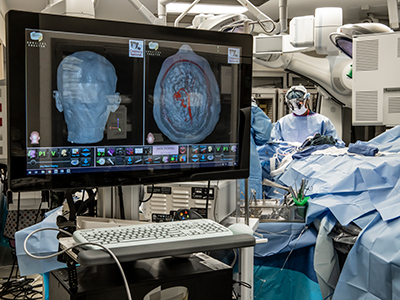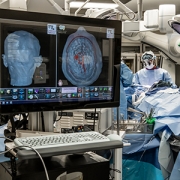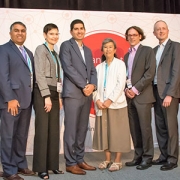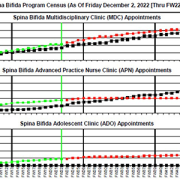Virtual reality allows surgical planning from every angle

The virtual reality surgical system projects images into the operating room, allowing neurosurgeons to revisit the surgical plan in real time.
Neurosurgeons at Children’s National Health System are getting a new three-dimensional (3D) perspective on their cases thanks to an FDA-approved breakthrough virtual reality surgical system.
Children’s National is the first pediatric health system in metropolitan Washington, D.C., to use this state-of-the art system, created by Surgical Theater. It seamlessly integrates patient-specific surgical planning and navigation, professional education and rehearsal.
The technology acquisition was made possible through a generous gift from Sidney & Phyllis Bresler, in honor of their children Alex, Jonathan and Amanda and grandson Theo Charles Bresler, and in loving memory of Joshua Stouck.
“Virtual reality modeling enables us to further explore, analyze and find the best approach for each unique surgical procedure,” said Children’s National President and CEO Kurt Newman, M.D. “This generous gift from Sidney & Phyllis Bresler should translate into better outcomes for many of the more than 17,500 patients who receive surgery at our hospital each year, and will benefit generations to come. We are deeply grateful for the Breslers’ commitment to pediatric innovation.”
The 3D, 360-degree view gives surgeons a cutting-edge digital tool to plan procedures in depth using an accurate capture of the patient’s unique anatomy, and also allows the surgeon to illustrate the surgical path in greater detail than ever before for patients and their families.
“Technology such as Surgical Theater’s represents a quantum leap for neurosurgeons, both in and out of the operating room,” said Robert Keating, M.D., chief of Neurosurgery at Children’s National, in a press release from the company. “It allows us to marry state-of-the-art 3D simulation to the real world; for the patient and family as well as doctors in training, and ultimately offers a new tool for the neurosurgical armamentarium in approaching complex lesions in the brain, such as AVM’s, tumors, epilepsy and functional cases.”











